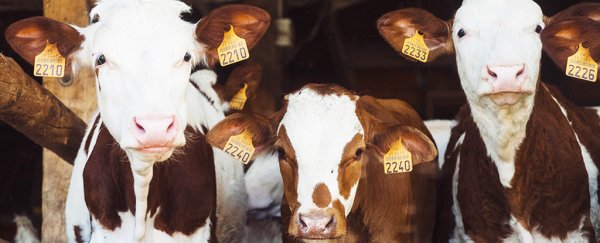US consumers are about to gain a rare window into the use of antibiotics in the food system, an issue of skyrocketing concern among public health groups, shoppers and physicians.
Critics have argued that the agricultural industry abuses these medicines, administering antibiotics to animals which do not need them and contributing to the rise of "super bugs."
Consumer groups have complained that the public knows too little about how their food is raised - an issue compounded by a range of confusing labels.
But thanks to a new San Francisco city ordinance, due to be signed into law later this month, a number of the country's top meat and poultry brands will soon have to share far more details about their antibiotic use.
Under the rule, which passed the city's Board of Supervisors unanimously on Tuesday, grocery stores will be required to document antibiotic use in the meat and poultry brands they sell and make the information available, via a city website, to consumers.
The ordinance will affect a number of supermarket chains with branches in San Francisco - including Safeway and Target - as well as their suppliers, which include Smithfield, Perdue and Tyson.
Both the grocery and meat processing industries described the new rule as an unfair burden.
Supporters say they hope it will bring much needed transparency to the national food system.
"We think this is a really important step forward," said Avinash Kar, a senior attorney at the Natural Resources Defense Council. "These are national brands, and we have, for the first time, a window into how they use antibiotics."
Like humans, animals raised for meat - including cows, pigs and chickens - receive antibiotics when they're sick to fend off bacterial infections.
The Food and Drug Administration banned the use of antibiotics for the sole purpose of promoting growth earlier this year.
But in many feedlots and broiler houses, animals continue to receive routine, preventive doses of antibiotics, designed to keep illnesses from spreading in close living quarters.
None of these uses pose an immediate threat to human health. Federal law regulates the safety of antibiotics on the market and the timing of dosages to make sure residues do not linger in your steak, pork chops or chicken.
Recently, however, public health and environmental groups have warned that high rates of antibiotic use in animal agriculture may contribute to the evolution of antibiotic-resistant "superbugs" that cannot be managed with traditional treatments.
Studies suggest that these bacteria, which evolve in the guts of poultry and livestock, can be passed to humans.
According to the Centers for Disease Control and Prevention, 2 million people are sickened every year by antibiotic-resistant bacteria, from any source.
And demand for antibiotic-free meat is growing among consumers.
A 2016 report by Nielsen found that sales of "antibiotic-free meat" grew nearly 29 percent each year between 2011 and 2015, compared to just under 5 percent for conventional meat.
An earlier survey by Consumer Reports found 86 percent of consumers wanted meats raised without routine antibiotics available at their supermarkets.
In response to these concerns, a number of meat, restaurant and grocery brands have taken steps to reduce or eliminate the use of antibiotics in their supply chains - as McDonald's did with chicken in 2016.
The San Francisco ordinance seeks to push the industry further, requiring grocery stores to document - for each meat and poultry brand they sell - the average number of days each animal received antibiotics, the percentage of animals affected and the total volume of antibiotics administered by that brand.
Ostensibly, the rule only applies to grocery and food retail stores with at least one location in San Francisco and a worldwide total of 25 stores or more.
But because that encompasses national chains including Safeway, Target, Costco, Whole Foods, Trader Joe's, Walgreens and CVS, the impact could be felt much further.
National meat brands that retail at those stores will also have to disclose how they use antibiotics.
Public health and environmental groups hope the measure will put pressure on the meat and grocery industries to stock products with lower levels of antibiotics.
"Consumers really care about this issue, and they have a lot of influence on the marketplace," Kar said. "So we hope that will push companies in the direction of better antibiotic use practices."
But the North American Meat Institute, a national trade organisation, and the California Grocers Association warned in comments submitted to the Board of Supervisors that the additional requirements could cause some brands to pull out of San Francisco and make meat and poultry in the city more expensive.
That was the outcome of California's last groundbreaking animal agriculture law, which required that chickens, hogs and cattle destined for state markets be raised above a minimum amount of space.
A study from economists at Purdue University found that prices jumped 33 percent immediately after the law went into effect in 2015.
"The San Francisco ordinance . . . is a recipe for failure," Barry Carpenter, the chief executive of the North American Meat Institute, said in a statement to The Washington Post.
"The significant costs associated with the segregation and record-keeping for meat and poultry products to be sold in San Francisco will increase the cost of meat and poultry for consumers there and reduce options available."
Some farmers are also worried the movement against antibiotics could prejudice consumers against their use for any reason.
"I see my cattle every day like some of your readers see their dogs," said James O'Brien, a horse breeder and cattle rancher in South Texas. "If they get sick, I want to treat them. To me, not using antibiotics is the inhumane practice."
2017 © The Washington Post
This article was originally published by The Washington Post.
